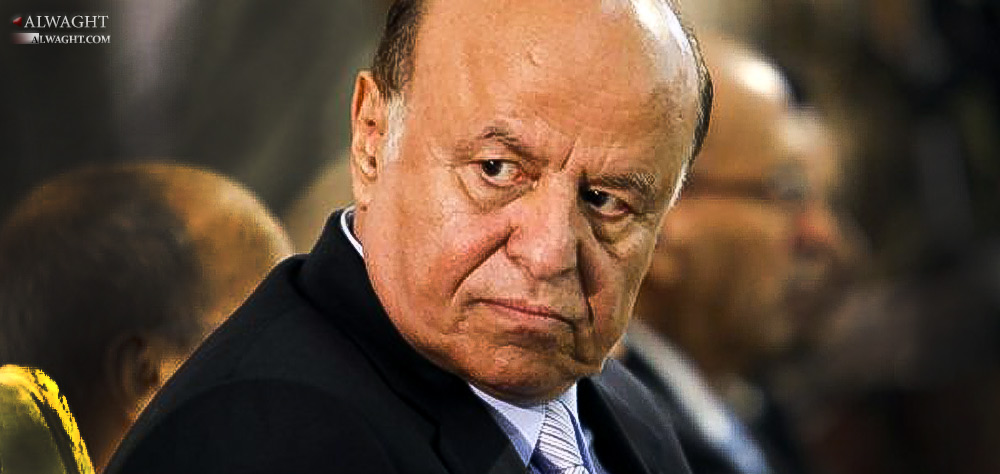Alwaght- While the Saudi-led war against Yemen is getting into its third year, the resigned Yemeni president Abed Rabbuh Mansur Hadi has officially talked about plans to introduce a federal system of governing to the country, a plan that more than Yemeni people will serve interests of Saudi Arabia, the US, as well as the Israeli regime in the region.
The argument about federalization of Yemen dates back to twenty years ago, namely five years after reunion of the former South and North Yemen governments. At that time, the scheme faced an opposition from Ali Abdullah Saleh, the then president of the country. However, after the revolution erupted in the country and when the peace negotiations started between the opposite Yemeni sides in 2013 and continued throughout 2014, the proposal of shifting to a federal system of governing for the country’s political system was put forward with support from Saudi Arabia. Breaking Yemen into six states or regions, the proposal won backing from Saudi Arabia, the US, and other Western sides. But at home it failed to garner advocacy, and other than the Yemen’s Muslim Brotherhood, that are majorly advocates of the Saudi Arabian policies, major parties have come against the suggestion.
Separation of Yemen to six states was put forward by Saudi Arabia with two key objectives: firstly, to restrict Ansarullah resistant movement to a new state called Azal, the ancient name of the city of Sana’a, the modern-day capital of the country. The aimed area has no access to the oil sources or the coasts. This deprivation was meant to eventually to undermine and obliterate the Yemeni resistant movement. Secondly, to give independence to the southern Hadhramaut province to ease the job of Saudi Arabia which wants to deepen its influence in the area to construct its oil pipelines from its deserts to the Arabian Sea and from there to the Indian Ocean.
The disagreement over the proposal between Ansarullah movement, which witnessed apparent conspiring by the foreign parties to eliminate it from the country’s political scene, and the government of Mansur Hadi at the end of the road culminated in what we are today seeing as a unceasing bombing campaign led by Saudi Arabia in the form of an Arab coalition against Yemen.
Using the military offensive, the Saudis were optimistic that they could briefly remove Ansarullah movement which is a serious opponent of the federalization plans. But after almost two years since the start of war and unremitting fighter jets' airstrikes, Riyadh has not yet made any progress toward its end.
When the United Nations raised efforts for peace in Yemen early this year, the federal system implementation was triggered afresh by the UAE and Saudi Arabia. The kingdom once again calculated that weakness and exhaustion of Ansarullah after 23 months of war will force the movement's leaders to concede to the split of Yemen.
In fact, the Al Saud is striving after drawing a secure line between Ansarullah and its territories at any costs. This effort is even more than ever critical for the Saudis especially now that Ansarullah has developed its missile capabilities and its capacity for striking Saudi military bases deep into the kingdom’s territories, including the recent missile attack that hit a military base just 40 kilometers off the Saudi capital, Riyadh.
The plan for introducing the federal system to the country once more was raised by Mansur Hadi on Tuesday, February 7, with an emphasis on confronting what the ousted president called the “Iranian influence”. The leading aim is to partition Yemen. The plan is overwhelmingly upheld by Saudi Arabia, the US, and the Israeli regime. According to the scheme not only Yemen will be split but also with achievement of sway in the so-called six states of a federalized Yemen by the Western allies of the Israeli regime the dangers that pose threats to Tel Aviv will be eliminated.
It is vital for the Israeli regime’s future life to dominate south and west of Yemen. If this end is met, Tel Aviv's vulnerability from the sea borders will be minimized. As part of Saudi alliance with the Israeli regime, King Salman of Saudi Arabia got ownership of two Red Sea Egyptian islands of Sanafir and Tiran and redirected their possession to Tel Aviv, a measure that fulfilled a major section of plan for guaranteeing the Israeli sea security.
Meanwhile, the future and unity of Yemen are heavily dependent on the power of the Ansarullah and Yemeni armed forces that are now engaged in battling the Riyadh-led Arab military alliance. If they can resist vigorously and save the areas under their control, they can seize new areas and form a national unity government in the country on the strength of running an erosive and costly war for Saudi Arabia. Otherwise, with the fall of Sana’a to the hands of the opposite side all the conditions will be ripe for federalization of Yemen and partition of the country at the end of the road.



























